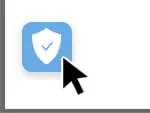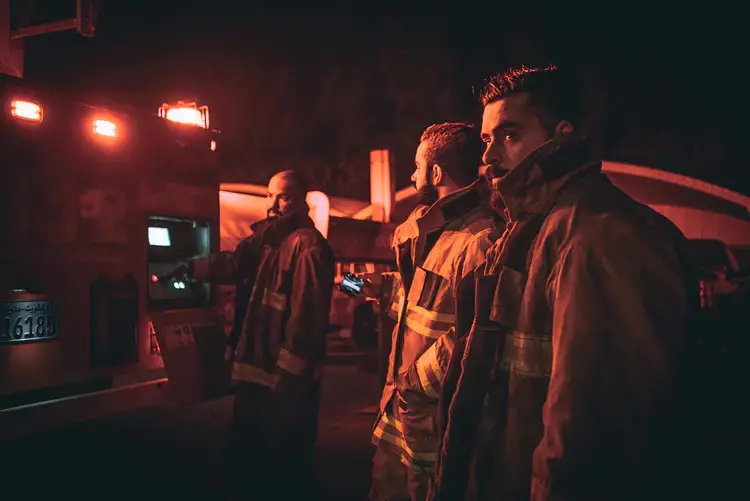
How to Conduct a Fire Drill at Work: A 5-Step Guide
Emergency preparedness saves lives. Ensure your team knows exactly what to do with a clear, well-practiced fire drill plan.
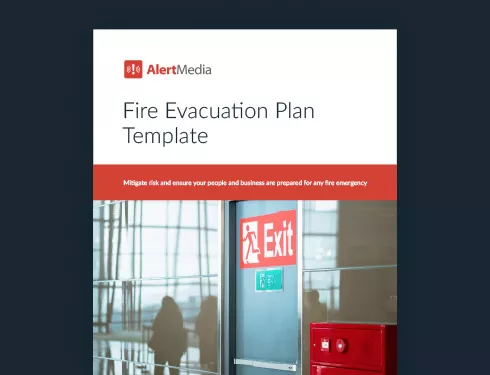
In the event of a fire, every second counts. Rick Rescorla, Morgan Stanley’s Security Chief at the World Trade Center, experienced this first-hand when he safely led 2,700 employees out of the South Tower on September 11, 2001. After surviving the 1993 terrorist attack on the Twin Towers, Rescorla was one of the few who saw the towers’ vulnerability, and he was sure they would eventually be attacked again.
Rescorla required that Morgan Stanley employees practice swift and orderly emergency evacuation drills every three months. He planned these drills as a response to a terrorist attack, in which fire would be only one of many deadly hazards. It’s a compelling example of how evacuation drills can effectively save lives.
Download Our Fire Evacuation Plan Template
Learn how your company can plan for a fire emergency, how to decide critical considerations for your emergency procedures, and how to prepare employees to exit the building safely in case of a workplace fire. Use an evacuation plan template or fire drill checklist to plan your response and make maintaining your fire drill log easier and faster.
Preview of our Fire Evacuation Plan Template
A fire drill is an evacuation simulation that prepares participants for a real fire emergency response. Running drills teaches people what to expect and how to respond safely.
During a fire drill, everyone will evacuate the building upon hearing an alarm or announcement and follow the fire evacuation plan as communicated. Fire drills differ from other emergency drills, such as shelter-in-place drills, in that building evacuation is the primary goal since a fire poses a risk to anyone in the building.
How Important Are Fire Drills at Work?
The National Fire Protection Association (NFPA) reports local fire departments responded to 1.39 million fires in 2023—roughly one fire every 23 seconds. These fires caused roughly 3,670 civilian deaths, 13,350 civilian injuries, and $23 billion in property damage. Given stats like this, your company would be wise to plan regular fire drills. Many landlords and office management companies require organizations to have emergency plans and conduct fire drills in their leases.
And emergency drills are not only to prepare for fires. They train employees on a number of life-saving skills, including:
- How to leave the office quickly in case of any emergency or life safety situation
- How to engage Environmental Health and Safety (EHS) when there’s a potential hazard
- How to locate escape routes and where to go after vacating the premises
- What to expect once emergency responders arrive
So, whether tied to your fire safety program, active shooter preparedness, or overall risk mitigation strategy, evacuation skills should be crucial to all employees’ training for emergencies.
Repetition is key to a successful outcome
Ask any school-age child about fire drills, and they will probably mention doing a mock emergency evacuation within the last few months. Schools repeat fire evacuation drills often, so the routine becomes a habit, and kids know what to do without thinking about it.
Fire drills are a great example of why emergency preparedness professionals typically “hope for the best; prepare for the worst.” Although there may be a low chance of a real fire in your facility, it’s still important to memorize the location and use of critical resources like fire exits, extinguishers, and emergency supplies so that if complications arise, your team knows how to respond.
In a fire emergency, evacuation routes could be blocked or doors jammed, and you will need alternative routes. Deaf and hard-of-hearing employees must be notified through a reliable channel other than a fire alarm or audio announcement since a fire alarm could be out of order. Regular fire drills will reveal these issues and more.
How to Develop a Detailed Fire Evacuation Plan
Before sending building occupants scurrying for the exits at the sound of a fire alarm system, make a detailed fire drill plan. A fire drill template can be invaluable here.
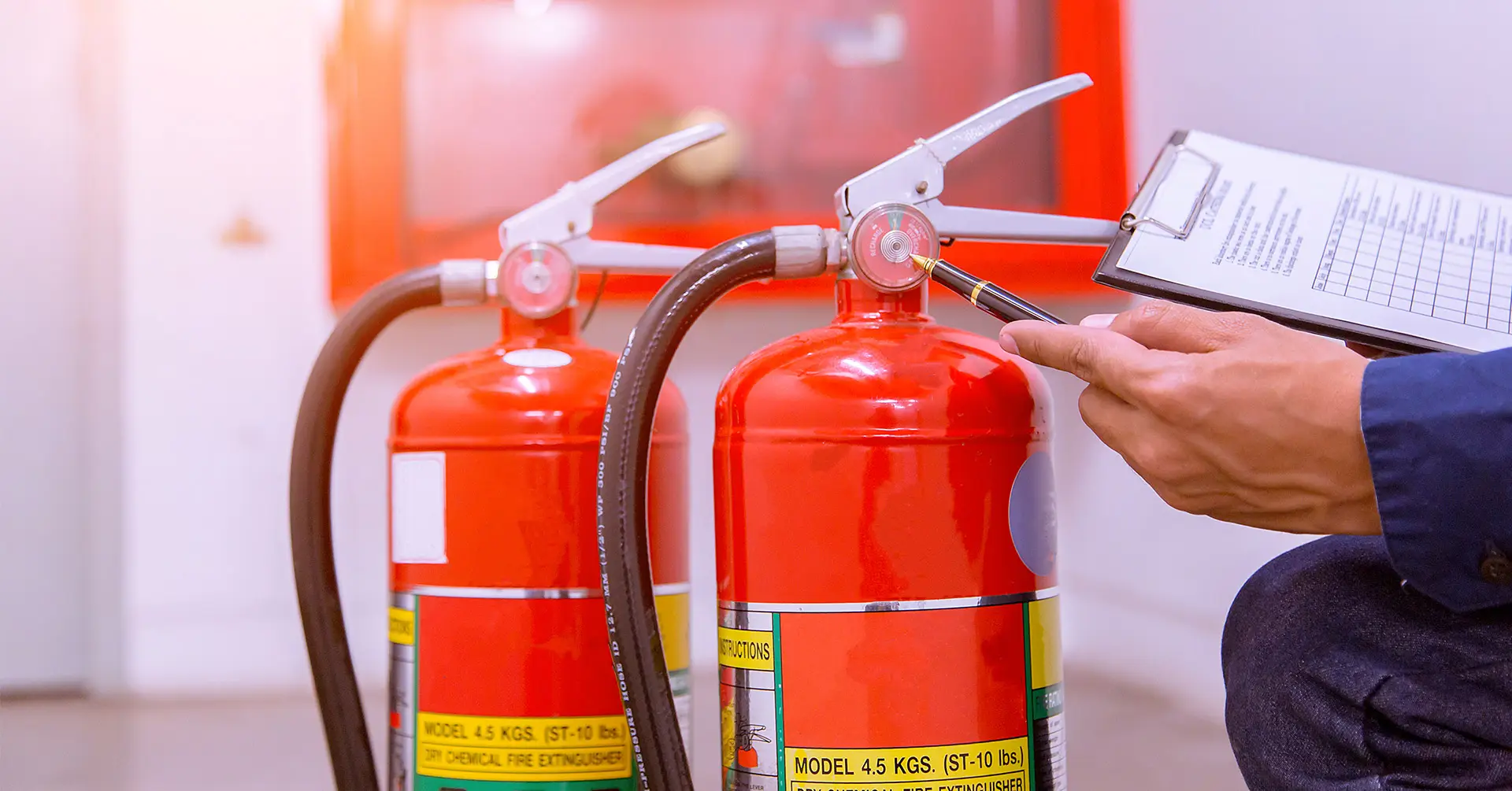
As part of this work, you’ll want to consider various scenarios:
- Where might a fire start?
- Are there areas of the building more likely to start fires, like kitchen appliances or chemicals in the warehouse?
- Do wildfires threaten your business?
- What is the fire code or maximum number of occupants for your building (and is your office violating it)?
- Is your HVAC maintenance up to date?
Here’s a look at the high-level steps to create a fire evacuation plan for your business:
- Establish roles and responsibilities for the fire evacuation team, including that of fire warden
- Develop comprehensive fire drill procedures
- Create a communication plan (using a multichannel, two-way emergency communication system such as AlertMedia makes this easy)
- Plan and map evacuation routes, emergency exits, and evacuation procedures
- Know your tools, such as smoke detectors, fire alarms, and fire extinguishers
- Rehearse evacuation fire drills at least twice per year
- Follow up and report using a modern employee notification system so you can determine the safety of all employees
Start with three key fire drill documents
Fire drill plans include a lot of assets, such as maps and checklists. However, three primary documents form the foundation of your organization’s fire drill collateral. They’re all related, but each serves a distinct purpose.
1) Fire drill policy
A fire drill policy is a high-level document describing your organization’s commitment to fire drills as a part of your overall safety culture. It should be written authoritatively, as the intended audience is senior leadership, regulators, and external stakeholders.
Your fire drill policy should include the following:
- An introductory statement describing the intent of your fire safety plan
- Legal and regulatory requirements to comply with
- Roles and responsibilities for leadership, emergency management team, and general employees
- Consequences of failing to comply with fire drill regulations
Frequency of fire drills and scope of operational impact
2) Fire drill protocol
Fire drill protocols are aimed at your fire safety group—safety officers, fire wardens, and emergency response team leaders. These protocols outline the procedures and steps for conducting fire drills, including the safety team’s responsibilities for overseeing the exercises.
Key components of a fire drill protocol are:
- Preparations such as scheduling, communicating plans, and coordinating with stakeholders
- Responsibilities during the drill, like activating alarms, defining exit routes, and performing headcounts
- Post-drill activity, including debriefing, evaluations, and record-keeping
- Developing specific scenarios to suit your organization’s composition and environment
3) Fire drill standard operating procedure (SOP)
Fire drill SOPs contain step-by-step instructions for conducting fire drills company-wide. The content of your SOP should be comprehensible to every member of your organization and focus on efficient and consistent participation in fire drills.
Make sure your fire drill SOP contains these elements:
- Detailed instructions for every role and activity in a fire drill, including employees who should focus solely on evacuating
- Checklists for activities before, during, and after the drill
- Troubleshooting tips and contingency plans, for example, if fire alarms don’t activate or external factors prevent carrying out the drill
- Visual aids and assets, such as maps, diagrams, and flowcharts
Fire Drill Procedures — Your 5-Step Plan
Step #1: Coordinate the plan
Now, it’s time to get down to the drill. With your fire evacuation plan in place, you know the escape routes. But it’s not as easy as heading to the nearest pull station and pulling the alarm. Everyone needs to be on board when you conduct a fire drill at work.
First, you must ensure the entire fire team (from the warden on down) is trained in the evacuation procedures and ready to make the drill successful.
Second, you need executive buy-in since the drill will remove people from the factory line, their desks, and the warehouse.
Third, and perhaps most importantly, all employees need to understand the importance of the fire drill and fire safety protocols; otherwise, they won’t take it seriously.
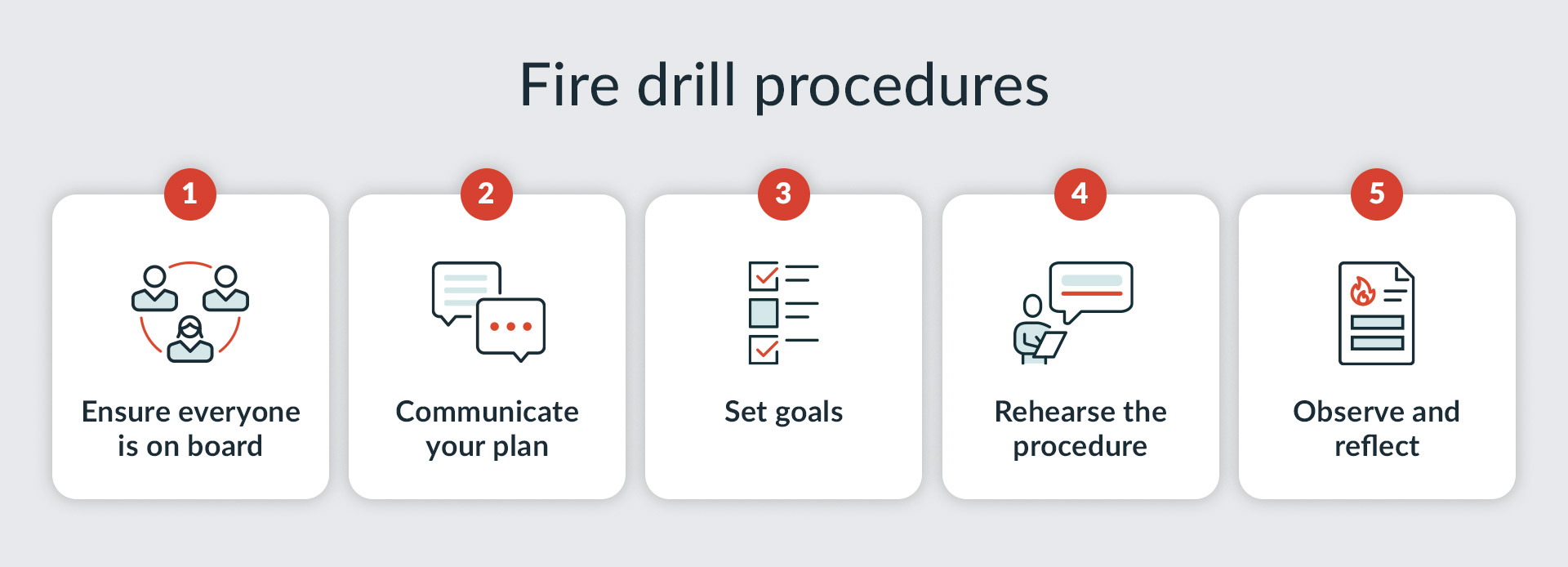
Step #2: Communicate with the team
The key to a successful fire drill at work is communication. Announce the drill across channels—including platforms such as an employee portal, intranet, website, Slack channel, newsletter, and text message. Employee communication software covering the most common communication channels will make this much more manageable.
Mark the time of the drill on the company calendar. Include information about the fire team and their roles, orderly evacuation routes, and expectations for the fire drill procedure and participants’ behavior.
“With fire prevention education, some organizations communicate a little too frequently. When it’s talked about too often, it becomes noise and employees will tune it out. But on the other end of the spectrum, when it’s not talked about enough, you can’t accomplish your safety and prevention goals. So, finding a middle ground for that is key.” — Brian O’Connor, Technical Services Engineer at NFPA
Here are a few examples of communication templates you can use for your fire drill. These can make notifying employees of an upcoming drill quicker and easier.
Sample Notification Templates for a Fire Drill
Fire drill announcement
A fire drill will be held in the [LOCATION] office on [DATE] at [TIME]. When the alarm sounds, evacuate the building (avoid elevators) and proceed outside.
Roll call survey
Are you safely evacuated from the [LOCATION] office? Reply with:
1 for NOT SAFE – still in building.
2 for NEED HELP – out of building.
3 for SAFE – out of building.
4 for SAFE – not in office today.
All clear announcement
The fire drill in the [LOCATION] office has concluded. Please return to your normal working stations. If you have any questions about the drill or process, reach out to [FIRE SAFETY WARDEN].
Step #3: Set goals for success
Your fire safety team should set goals and standards for the drill. If you include these in your first drill, you can work to improve them in subsequent drills. For instance, if your first drill takes 15 minutes to get all occupants safely outside because you discover people are visiting the restroom or wrapping up calls, you have work to do.
Some metrics to measure:
- Time from drill activation to complete evacuation
- Time to report completion of the drill
- Successful shutdown of equipment (where appropriate)
Step #4: Practice the fire drill plan
Conduct rehearsals of increasing complexity. For example, your fire safety leaders could first rehearse “on paper” with a tabletop exercise where they describe the evacuation process to the fire warden. The team should describe their actions during a fire drill and analyze any perceived weaknesses or confusion.
After the fire safety leaders understand their roles, they should physically walk through the fire drill. Next, conduct a full rehearsal with as many employees as possible. Large companies may favor doing this by building or section to prevent business disruptions.
Introduce challenge scenarios
Once your employees have mastered a basic fire drill, your fire safety leaders should design more intricate scenarios. Change up variables within the drill to train employees to react when complications arise. Disasters don’t often go according to plan, and simulating a more realistic environment improves fire safety training overall.
Some examples of fire drill scenarios to practice:
- Fire sources and scopes: A small fire starting in a janitorial closet can have a different impact than a large one engulfing a commercial kitchen. Model the fire’s complications, such as chemical exposure, and proceed accordingly.
- Obstacles: Say your company is in a four-story building and a fire has blocked a main stairwell on the ground floor. Your team must communicate the obstacle and re-route traffic to minimize congestion and expedite safe evacuation using alternate routes.
- Secondary complications: Imagine it’s the middle of winter and your team’s primary assembly point would expose employees to inclement weather. Who decides when to proceed to a secondary assembly point, and how smoothly does the process go?
- Industry-specific factors: Consider ways a fire could harm organizations in your industry. For example, healthcare groups need to consider not only their employees’ safety but also patients who may be incapable of evacuating on their own. What if a fire starts during a surgical procedure or overnight when staffing levels are reduced?
Remember, running specialized scenarios shouldn’t be treated as a pass-or-fail exercise. It’s more important to discover why your plans went awry so you can improve them and be better prepared for a real disaster.
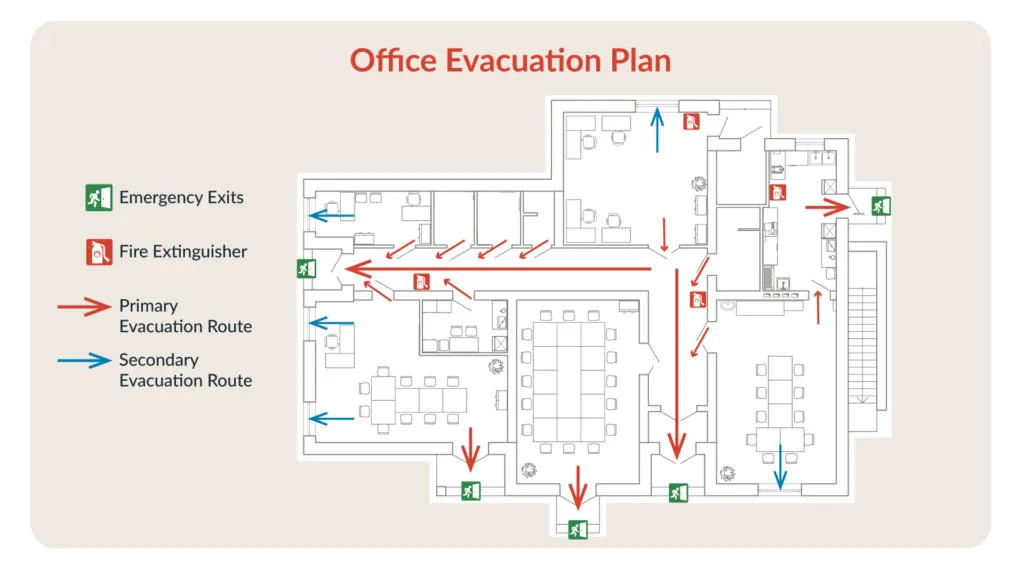
Establish and use the assembly point
Fire drills are unsuccessful unless every employee is accounted for outside the building. This crucial step occurs at the assembly point. The designated area should be a familiar and agreed-upon location a safe distance away from the building. For large companies, multiple assembly areas allow for maximum efficiency with a separate fire team leader at every point.
Companies with a mass emergency notification system, such as AlertMedia, can use the survey feature and event pages to track the status of employees who have yet to reach their assembly area. For those who may have lost their cell phones while evacuating, fire team leaders should also use old-school roll calls to ensure every employee is safe.
In the event of an actual fire, fire team leaders should follow the predetermined reporting protocol and immediately alert the fire department and the entire fire team if someone is missing.
Step #5: Reflect and improve the plan
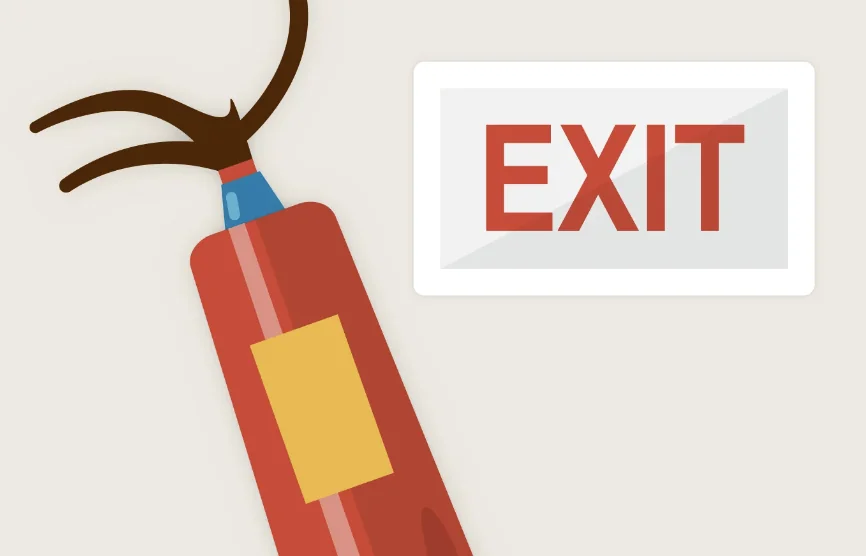
When you conduct a fire drill at work, choose a few people who are not on the fire evacuation team to act as neutral observers. Task them with looking for the following:
- Large groups moving slowly or talking with each other
- People on cell phones or using other mobile devices
- Unhelpful behavior, such as grabbing coats, purses, and bags
- Difficulties for people with disabilities or mobility impairments, such as hard-to-open doors or slippery stairwells
- Employees who choose a different route rather than the nearest exit to their workstation
After the drill, the observers should conduct a debriefing or compile an after-action report to review their observations. The meeting location is a convenient place to perform this debrief since memories of the drill will be fresh.
Gather the fire team together to review what happened and what can be improved next time. Assess all the steps above and compile notes into the fire drill report on what worked flawlessly and what was sub-par.
Deep dive into questions such as:
- Did employees close the doors upon exiting rooms?
- Were employees calm and confident?
- Did everyone meet at their assigned meeting spot?
- Was the fire alarm reset, and was the alarm company notified of the drill? (if applicable)
- Did all employees get the alert from your emergency notification system?
- Did the building facilities (exit doors, alarm activation, automated voice commands) work correctly?
You can also use a fire drill log, such as the one included in our Fire Evacuation Plan Template, to keep track of your fire drill reporting so you have a record of how often your evacuation drills occur.
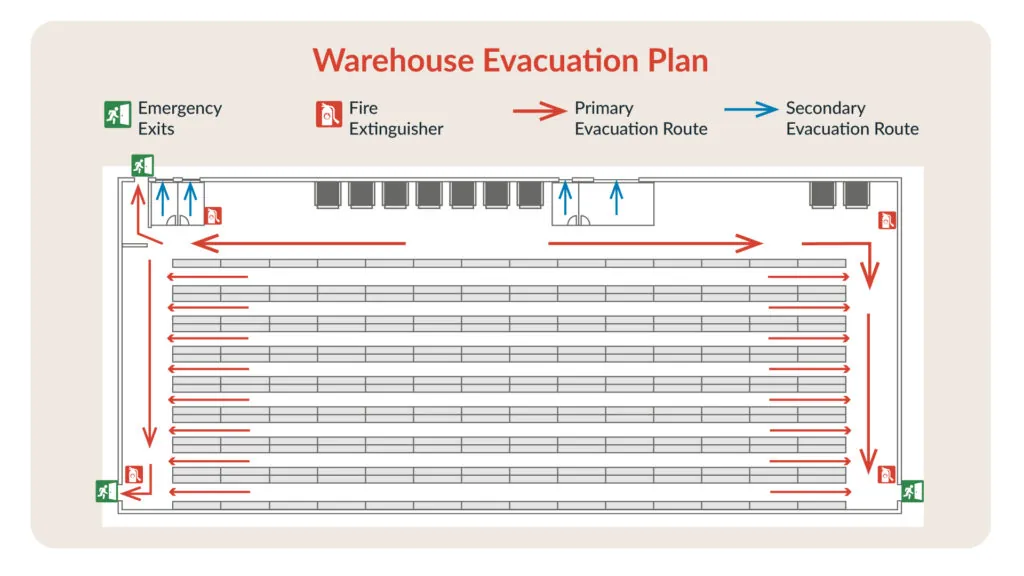
— Brian O’Connor, Technical Services Engineer at NFPA
Other Considerations to Improve Fire Safety
Here are some other things to consider as you plan for your fire drill at work:
- Incorporate realistic scenarios for future drills, such as “this hallway is in flames” or “this door won’t open.” Challenge leaders and employees to identify an alternative safe route.
- Have managers lead a simple walkthrough of the evacuation route during employee onboarding.
- Conduct drills randomly to simulate a real-world scenario and improve overall preparedness.
- Conduct drills every three months if your company operates with extensive chemicals and equipment. For most other organizations, twice per year is adequate.
- Replace key fire safety leaders who leave the company and do a leaders-only walkthrough of the fire drill procedures.
Preparing for a fire evacuation is a serious matter. With the health and safety of your team at stake, thorough planning is critical.
As long as you are clear with your employees about what is expected of them and how it will benefit them, everyone will appreciate the effort to make your safety fire drills efficient and professional. And everyone will be confident about exiting the building safely during a fire.
Frequently Asked Questions About Fire Drills
General fire drill questions
- What is the difference between a fire drill and an evacuation drill? Fire drills are a specialized type of evacuation drill. They focus not just on safely evacuating, but navigating the obstacles fires can cause, such as smoke and blocked exits.
- What are the different types of fire drills? There are three types of fire drills: Comprehensive fire drills go through the full procedure, from activating the fire alarm to a full headcount at the assembly point, silent fire drills allow specific departments or groups to practice their role in a fire drill, but without activating the fire alarm and disrupting company-wide operations, and table-top fire drills model the conditions for a fire drill and allow safety teams to explore and refine fire drill procedures step-by-step.
- Are there different types of fire drills for different industries? While every organization should perform general fire drills, many companies have industry-specific requirements. Common examples include businesses working with dangerous chemicals or heavy equipment.
- What is the value of fire drill training in the workplace? Aside from legal and regulatory compliance, fire drills are essential for promoting workplace safety and preventing injuries or even deaths. In the event of a fire, every employee will be responsible for getting themselves to safety—fire drills give them the practice they need to do so quickly and effectively.
- How do fire drills fit into overall emergency preparedness plans? Fire drills are a core component of an emergency preparedness plan. While you could face any number of different reasons to evacuate, fires are one of the most common workplace emergencies. Your fire drill plans should be kept updated in tandem with other evacuation protocols and procedures for managing employee safety.
- How often should fire drills be conducted in the workplace? Most companies should perform comprehensive fire drills twice per year. Organizations working with chemicals, heavy equipment, or other specialized requirements should perform quarterly fire drills.
- How long should a fire drill take? Depending on the size of your building and team, fire drills will usually take between five and thirty minutes. If it’s taking longer, consider ways to streamline the process.
- What is the benefit of a fire drill checklist? A fire drill checklist ensures you follow every procedural step during the exercise. Consistency is critical, as the goal is to make evacuating feel routine enough to do it quickly and safely, even during a real emergency.
- What is a fire drill report? Fire drill reports give you an objective look into how well your fire drill simulation went. Details might vary based on your compliance requirements, but every fire drill report should include: who was responsible for the fire drill, date and time of the drill, records of the pre-drill notifications, roster of employees present and participating, any special conditions you included in the scenario, problems encountered during the fire drill, how many occupants evacuated, and how long the entire drill took.
- What is the purpose of a fire drill log? A fire drill log is essentially a collection of your post-drill reports. For most companies, maintaining a fire drill log checks a regulatory box. But it also helps you identify trends in your fire drills—both positive and negative. Past performance helps shape your fire evacuation plans, and seeing how changes play out in action is a critical part of the feedback loop.
- What is the benefit of using a fire drill procedure template? Fire drill procedure templates are a framework for ensuring a comprehensive drill and evacuation plan. Every member of your company needs a defined role—whether coordinating a safety team or simply evacuating—and a procedural template prevents details or responsibilities from slipping through the cracks.
Legal and regulatory questions
- What are the legal requirements for fire drills in the workplace? Fire drill requirements vary by state and city, but most organizations must perform drills at least twice per year. Some companies have more stringent guidelines based on use of chemicals and heavy equipment or other specific aspects of the workplace environment.
- What is the OSHA standard for fire drills? Technically—and surprisingly—OSHA doesn’t have a specific guideline requiring companies to perform fire drills. However, if your emergency action plan or emergency response plan contains any language about safety drills, then OSHA does require you to actually implement and perform the drills. Additionally, most companies must comply with OSHA fire safety standards, which can often lead to an indirect requirement to perform fire drills.
- What role do fire drills play in ISO 27001 or other compliance frameworks? While ISO standards are extremely broad, most security frameworks contain provisions for emergency preparedness and evacuation drills. Your company’s scope and implementation of ISO standards will impact your responsibilities. But in general, you should include standards compliance as a key input when designing your fire drill policy.
- Are there global fire safety regulations? There are no globally enforced fire safety regulations. The International Fire Code (IFC) is a worldwide standard, conforming to (or exceeding) most countries’ basic fire safety rules, but it only acts as a recommendation. International organizations should consult with regulatory bodies on whether they operate to ensure legal compliance.
- How do I update my fire drill procedures to reflect new safety regulations? It’s important to include regulatory updates in the preparatory phase for fire drills. Your safety plan should have specific points of contact to manage the compliance side of evacuation preparedness. Their input will be critical when you revisit, update, and refine fire drill plans. For larger companies, especially those with multiple locations, working with the local fire marshal can help improve your fire preparedness.
Problem-solving questions
- What are some common fire drill mistakes during workplace exercises? One of fire drills’ key purposes is to discover mistakes in your plans. But even without flawed details, there are many ways fire drills can go awry: ignoring the fire alarm, taking time to retrieve personal belongings, using the wrong exit route, not going to the correct assembly point—or any assembly point at all, failing to follow roles and responsibilities, and ignoring instructions or ongoing communications.
- How do you conduct fire drills for remote or hybrid workforces? The rise of hybrid work has complicated fire drill practice. In general, it’s best to schedule your fire drills when as many staff members will be on-site as possible. If your company operates on a split schedule, you’ll likely need to schedule rotating drills to cover all of your employees. For fully remote teams, focus on developing fire safety education around the home office. Work with remote employees to determine safe assembly points around their homes and encourage them to assess their fire preparedness on a person-by-person basis.
- What should you do if someone is missing during a fire drill? If someone is missing during a fire drill, treat it like an actual emergency. Notify your fire warden or designated first responders liaison so they can begin searching for the person.
- How can you ensure a fire drill is inclusive for employees with disabilities? You should bake inclusivity for disabilities into your evacuation plans, so fire drills reflect exactly what would happen during an emergency. Accommodations vary by disability, but there are some common themes in fire drill planning: ensuring hearing-impaired employees have an alternative to audio fire alarms and making safety team members responsible for physically impaired employees who might not be able to evacuate by themselves.
- What is the best way to communicate with employees during a fire drill? It might be tempting to use your digital messaging platform, but you don’t want employees staring at their phones in the middle of a fire drill. If you need to communicate during a fire drill, use a PA system, megaphone, or other amplification to verbally convey information as concisely as possible.
- What technology can improve fire drill preparedness? Technology might not be available during a fire, but it’s an asset in fire drill training. There are a few common tools you can use: a digital emergency messaging platform to manage notifications and status updates, digital mapping and virtual reality to simulate evacuation routes in different conditions, and existing security infrastructure like badge tracking can monitor traffic flow and make sure employees are using the correct exit routes.
- How do you handle fire drills in high-rise buildings or large facilities? If your organization occupies an entire building, you can coordinate your fire drills internally. However, occupying only part of a facility can add complications. It’s best to work with your property manager to make them aware of your plans and ensure other tenants won’t disrupt your fire drill (nor will you disrupt their business).
- Can fire drills be conducted during bad weather? Unless you have an organizational need to perform fire drills in bad weather, try to avoid it. Exposing your employees to extreme weather is a safety hazard by itself, and making fire drills needlessly unpleasant will reduce engagement.
Safety culture questions
- How do fire drills improve overall safety culture? From a detailed perspective, fire drills familiarize employees with their evacuation routes and roles in the event of an emergency. The evacuation drill simulations confirm everyone knows where to go, what to do, and how to act without hesitation. At a high level, fire drills establish an organization-wide commitment to safety. They engage every team member in the process, fostering a sense of preparedness, rather than helplessness in the face of a disaster.
- How can you enhance employee engagement in fire drills? Fire drill practice without effort and attention is a waste of everyone’s time. There are a few ways to promote employee engagement in fire drills: have company leadership reinforce that fire drills aren’t distracting from work duties—they’re a part of work duties, provide clear and concise communication about when drills will take place and what you expect of employees, and give employees personalized feedback on their performance so they understand how they did and feel empowered to protect themselves in an emergency
- How do you improve your organization’s fire drill performance over time? Practice makes perfect, but only with proper tracking. Maintaining a thorough fire drill log will allow you to monitor your fire drills over time and discover if shortcomings are due to inefficiencies in your procedures, employee performance, or unplanned external factors.
- What are some fire drill evaluation metrics to measure the success of a simulation? Depending on the size of your company, you might have specific important statistics. But there are key metrics for most organizations: how many employees evacuated, how long the evacuation took, the number of notifications sent, seen, and responded to via your emergency messaging platform, percentage of employees who used their primary evacuation route, and explanations from those who used a secondary route, how long headcounts took at your evacuation assembly point(s), and total time from beginning of the drill to final headcount

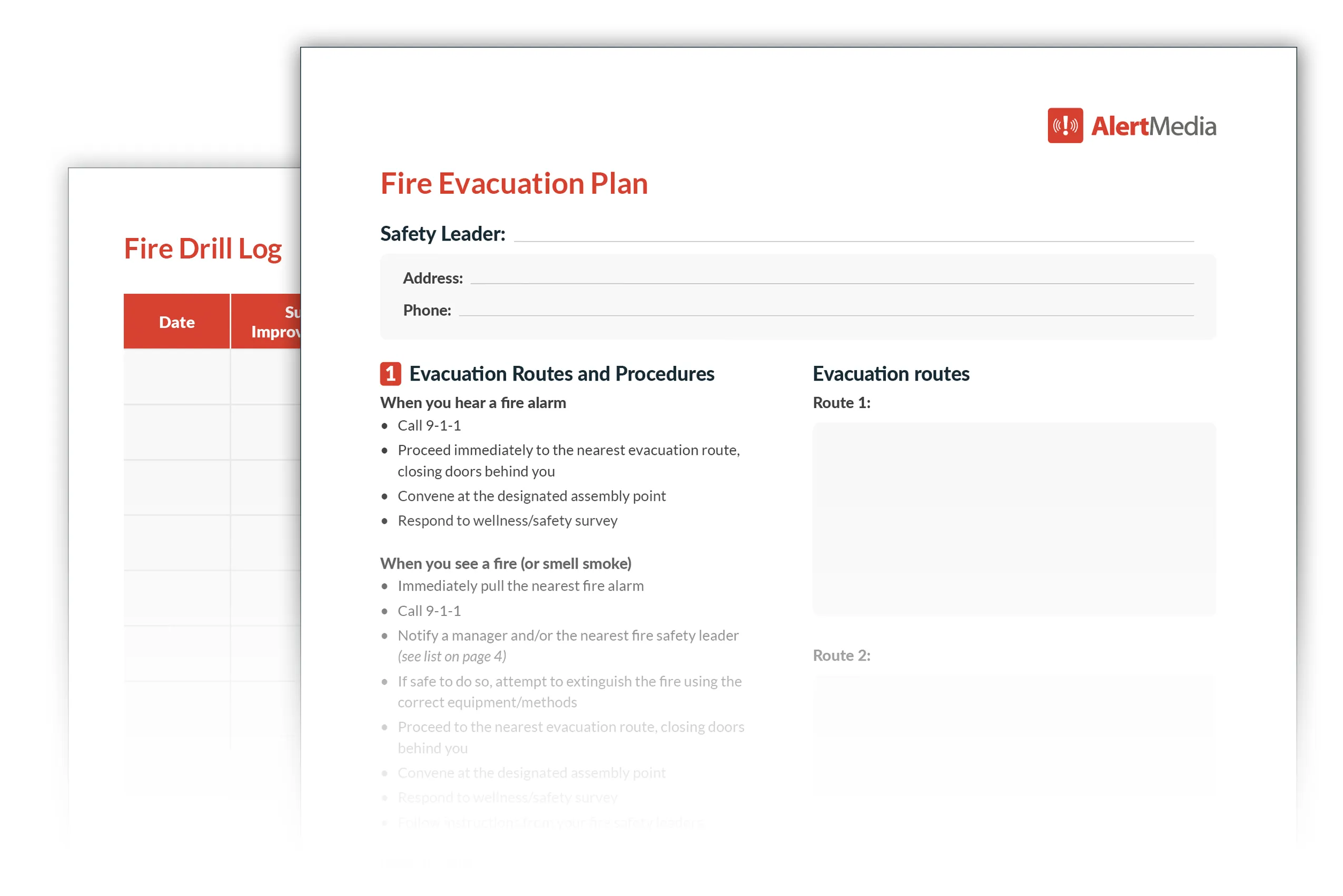
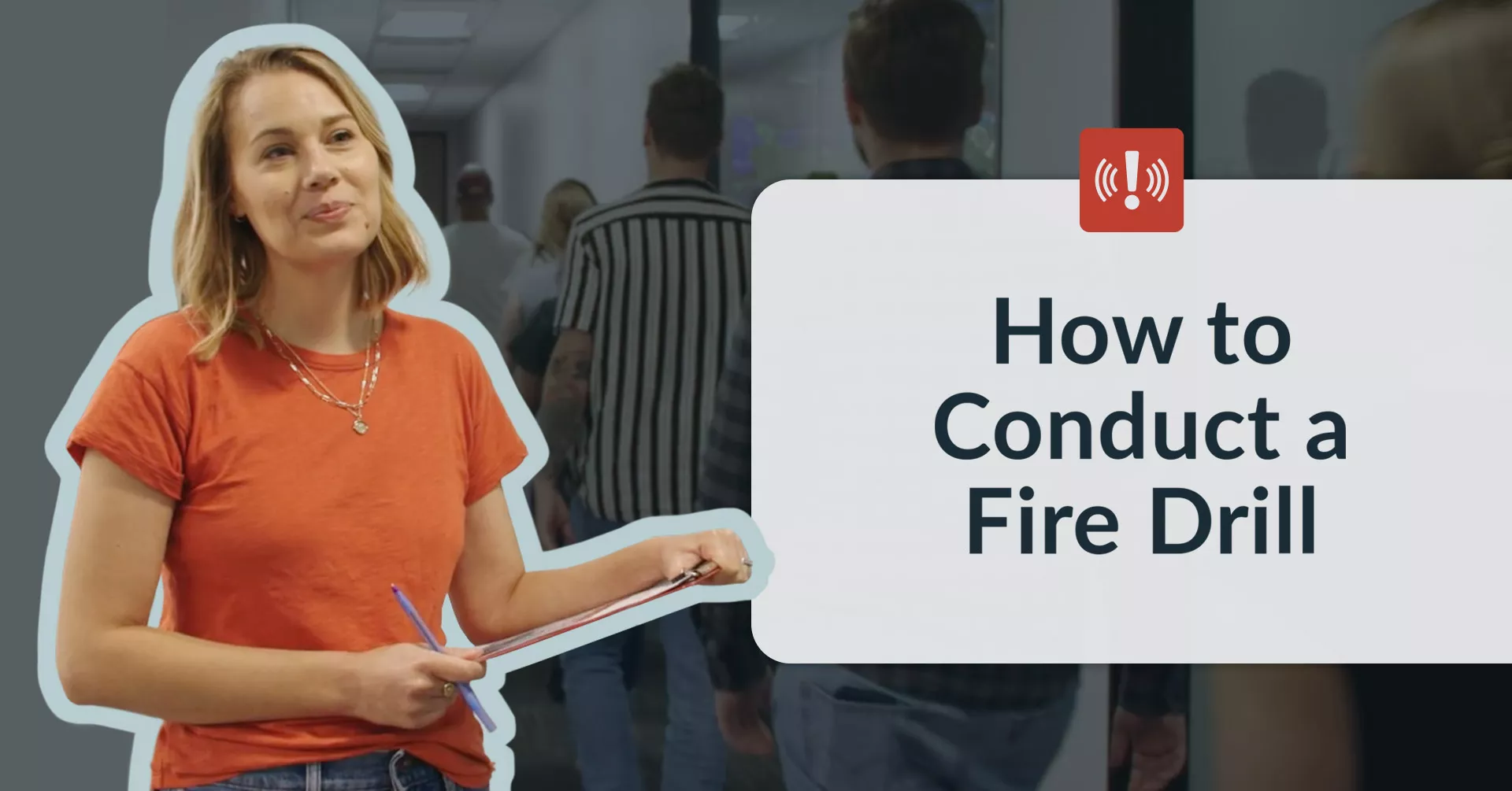
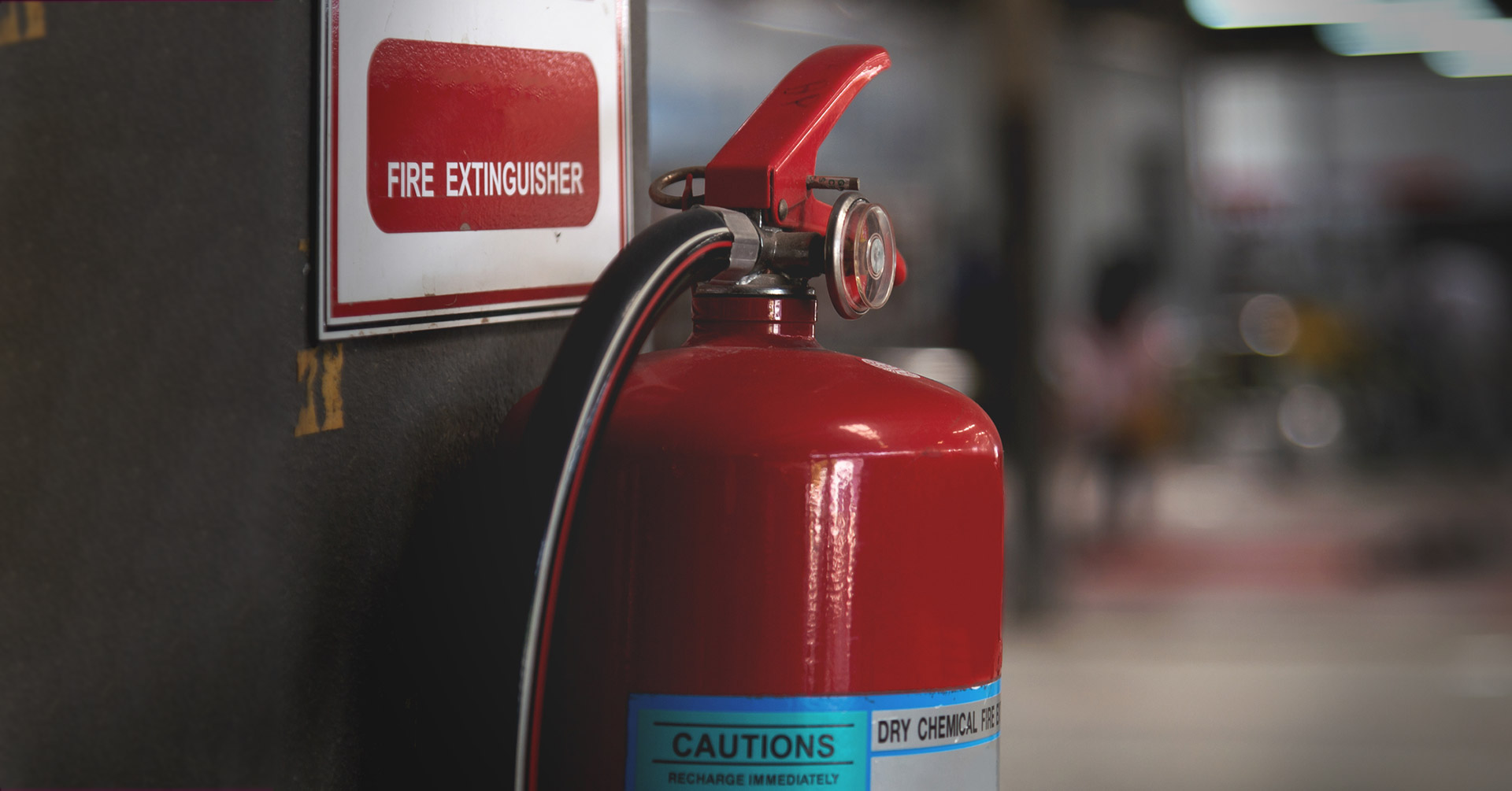
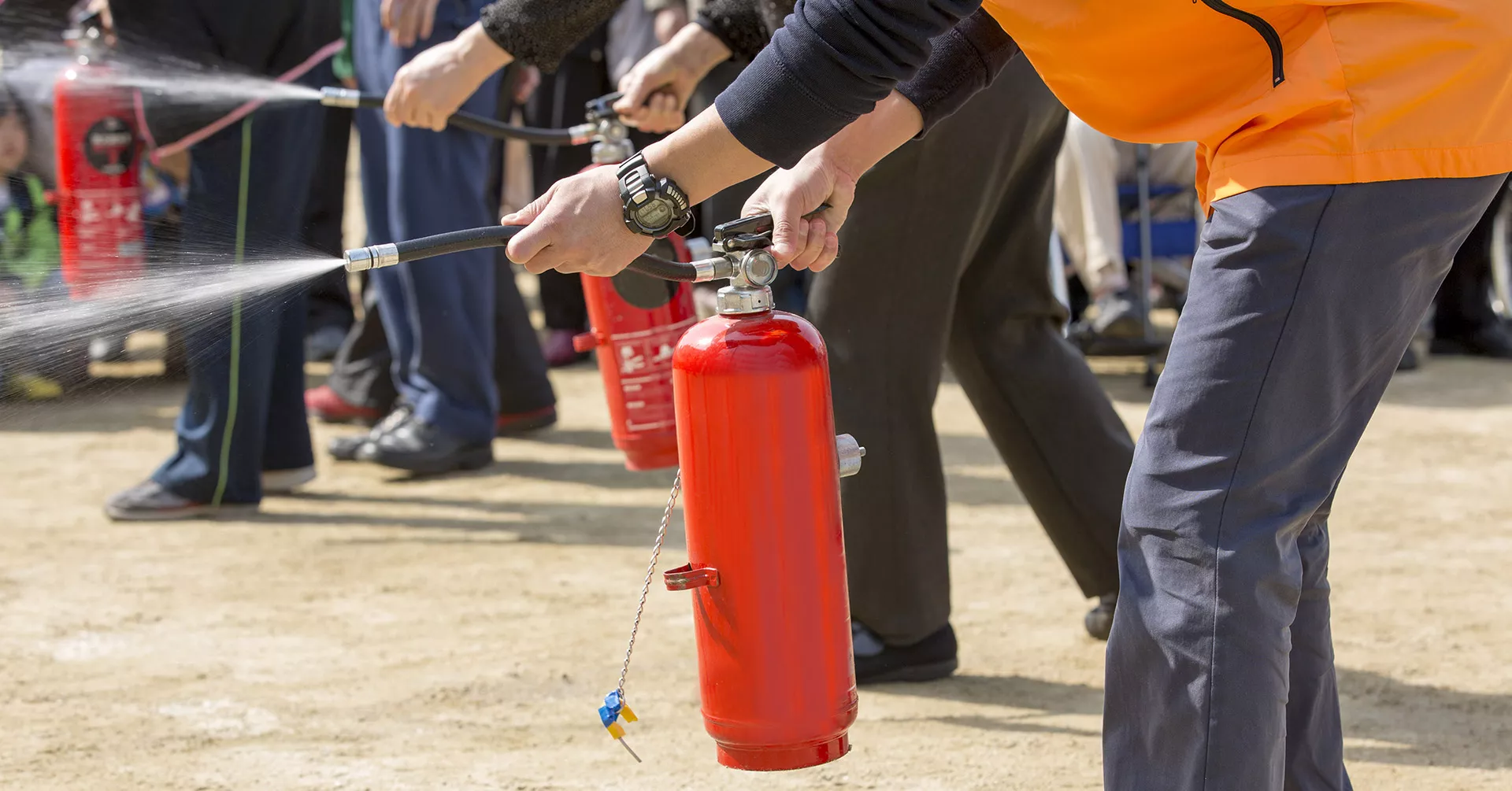
![How to Create a Fire Prevention Plan [+ Free Guide]](https://www.alertmedia.com/wp-content/uploads/2022/08/Blog-Fire-Prevention-Plan-v1.jpg)
